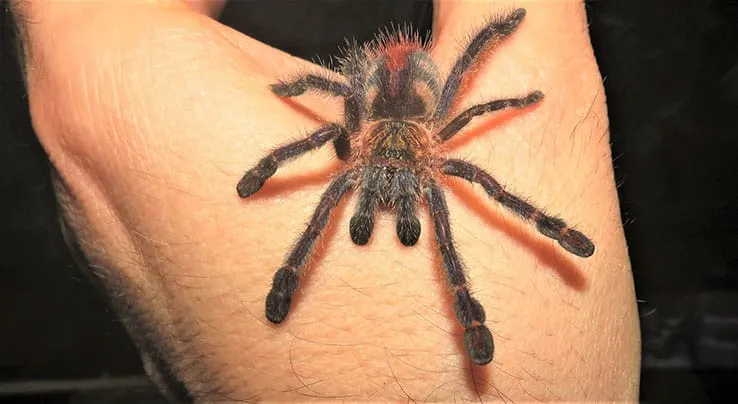What is the Amazon Sapphire Tarantula?
The Amazon Sapphire Tarantula, scientifically known as Tapinauchenius violaceus, is a captivating species of tarantula highly sought after by arachnid enthusiasts. This New World tarantula gets its common name from the stunning iridescent blue and purple hues that adorn its legs, carapace, and abdomen. Native to the rainforests of South America, particularly in areas of French Guiana, Suriname, and Brazil, this species is known for its arboreal lifestyle, meaning it spends a significant portion of its life in trees. The Amazon Sapphire Tarantula is a relatively fast-growing species, and its beauty, combined with its manageable size, makes it an attractive pet for experienced tarantula keepers. Understanding the characteristics and needs of this species is essential for anyone considering owning one.
Origin and Habitat
The Amazon Sapphire Tarantula originates from the tropical rainforests of South America. These tarantulas are primarily found in the humid, warm environments of French Guiana, Suriname, and Brazil. Their natural habitat consists of trees, where they build silken retreats, often in the crevices of tree bark or among the foliage. This arboreal lifestyle shapes their behavior and physical characteristics, including their agility and the structure of their claws, which allow them to climb effectively. The consistent warmth and high humidity levels in their native environment are crucial to their survival. They are often found near streams or other water sources, which contributes to the high humidity levels necessary for their health and well-being.
Appearance and Characteristics
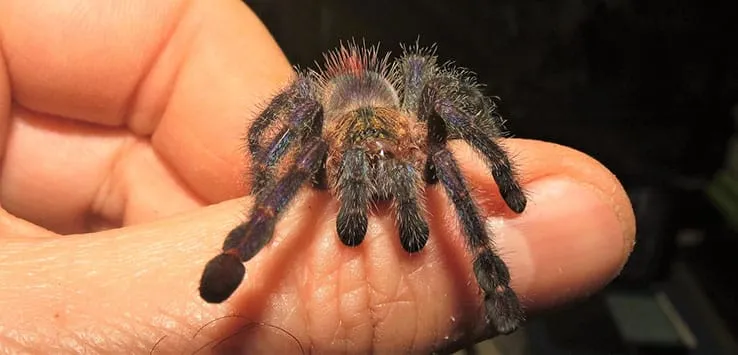
The Amazon Sapphire Tarantula is one of the most visually striking tarantulas due to its vibrant coloration. The body of this tarantula is typically covered with a dark carapace, while the legs and abdomen display a magnificent blend of blue and purple iridescence. The hairs on their legs create a velvety appearance, and the contrast between the dark body and the bright legs makes them stand out. Their chelicerae, the mouthparts used for biting, are often a deep black color. The Amazon Sapphire Tarantula is not only beautiful but also relatively small compared to some other tarantula species. The combination of their striking appearance and manageable size contributes to their popularity among spider enthusiasts.
Distinctive Sapphire Blue Hues
The iridescent sapphire blue hues are the most captivating feature of this tarantula. These colors are not due to pigments, but rather to the structure of the hairs on the tarantula’s legs and body. The way light interacts with these structures creates the vibrant, shimmering effect. The intensity of the blue can vary depending on factors such as the tarantula’s age, health, and even the angle of light. The blue and purple colors often appear more pronounced during molting, when the new exoskeleton is forming. This striking coloration is a key reason why the Amazon Sapphire Tarantula is so highly prized by collectors, making it a true gem in the world of arachnids.
Size and Lifespan
Amazon Sapphire Tarantulas are considered a medium-sized tarantula species. Females typically reach a leg span of around 5 to 6 inches, while males are often slightly smaller. The overall size of these tarantulas makes them relatively easy to handle and care for, which adds to their appeal as pets. As for lifespan, female Amazon Sapphire Tarantulas can live for up to 8 to 10 years or even longer in captivity, provided they receive proper care and nutrition. Male tarantulas, on the other hand, have a significantly shorter lifespan, usually around 2 to 3 years after reaching maturity. This difference in lifespan is typical for many tarantula species.
Behavior and Temperament
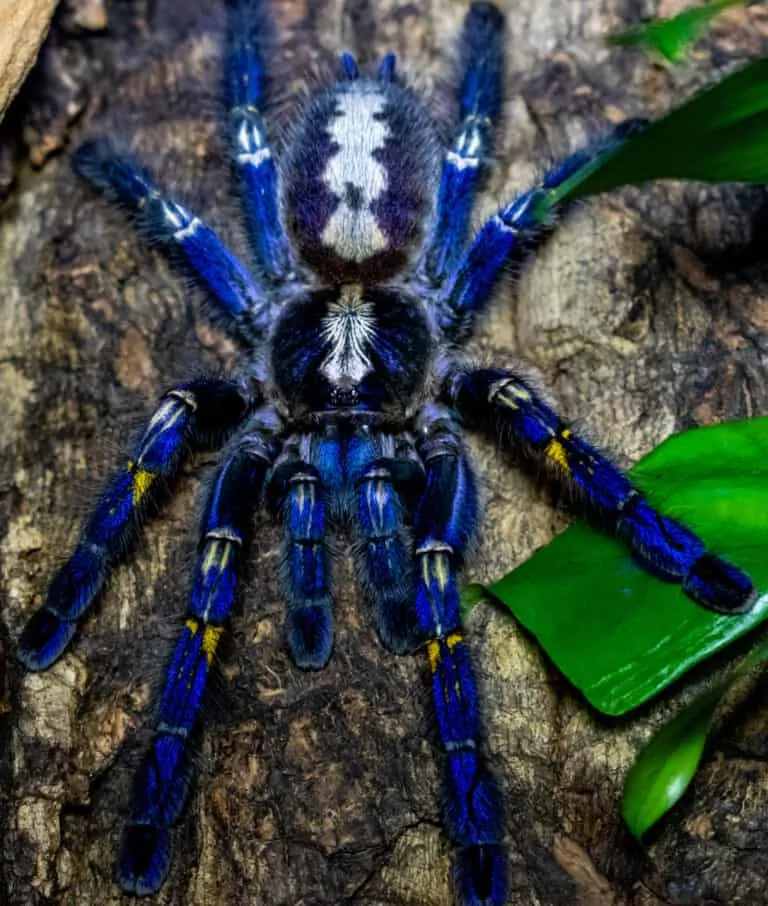
The Amazon Sapphire Tarantula is known for its relatively skittish nature. They are fast and agile, often preferring to flee or hide if they feel threatened. While they are not typically aggressive, they will defend themselves if they feel cornered or provoked. Their arboreal lifestyle means they are adapted to climbing and moving quickly through their environment. When kept in captivity, they will often retreat to their hiding places if disturbed. This behavior underscores the importance of providing them with a suitable enclosure that includes plenty of hiding spots and a secure environment where they can feel safe. Their speed and tendency to bolt require careful handling and understanding.
Aggression Levels
The aggression levels of Amazon Sapphire Tarantulas are generally considered to be low to moderate. They are not typically prone to biting unless they are provoked or feel threatened. Their first line of defense is usually to flee or flick urticating hairs, which can cause skin irritation. However, like all tarantulas, they can bite if they are cornered or feel their lives are in danger. The venom of the Amazon Sapphire Tarantula is not considered medically significant to humans, but their bite can still be painful. Proper handling techniques, a calm environment, and respect for their space are crucial to minimizing the risk of aggression.
Venom Potency
The venom potency of the Amazon Sapphire Tarantula is relatively mild. While their bite can cause local pain, swelling, and redness at the bite site, it is not considered dangerous to humans. Unlike some other tarantula species, their venom is not potent enough to cause severe systemic symptoms. However, it is still important to avoid being bitten and to exercise caution when handling them. If bitten, it is important to clean the wound thoroughly and monitor for any signs of infection. Most bites from Amazon Sapphire Tarantulas are not serious, but it is still wise to seek medical attention if you experience any unusual or severe symptoms.
Caring for an Amazon Sapphire Tarantula

Caring for an Amazon Sapphire Tarantula requires attention to detail to ensure their health and well-being. Their needs revolve around creating a secure and comfortable environment that mimics their natural habitat, which will help them thrive. This includes providing an appropriate enclosure, maintaining correct temperature and humidity levels, and feeding them a suitable diet. Regular monitoring and maintenance are crucial to prevent health issues and ensure a long and healthy life. This section provides a comprehensive guide to the proper care of an Amazon Sapphire Tarantula.
Creating the Ideal Enclosure
The enclosure is a critical aspect of caring for an Amazon Sapphire Tarantula. A suitable enclosure should be appropriately sized for the tarantula’s current and expected adult size, typically a terrarium or a specialized reptile enclosure. For an adult, a ten-gallon tank is usually sufficient, though larger enclosures are always better. The enclosure should have a secure lid to prevent escapes. Ventilation is essential to allow for air circulation and maintain appropriate humidity levels. It is important to ensure the enclosure is escape-proof, as these tarantulas are quick and can easily slip through small openings. The choice of enclosure material, whether glass or plastic, is less critical than the features that the enclosure provides.
Substrate and Decor
The substrate, the material on the bottom of the enclosure, should be carefully selected. A good substrate for an Amazon Sapphire Tarantula should retain moisture and allow for burrowing or climbing if desired. A mixture of peat moss, coconut fiber, and vermiculite is often a good choice. These materials help to maintain the necessary humidity levels and provide a naturalistic environment. Decor is also important for enriching their habitat. Include cork bark, branches, and artificial plants to mimic their natural arboreal habitat. These elements provide hiding places and climbing opportunities, which reduce stress and provide enrichment. Make sure all decorations are secure to prevent them from falling and harming the tarantula. Adding a shallow water dish is important, too, for hydration.
Temperature and Humidity
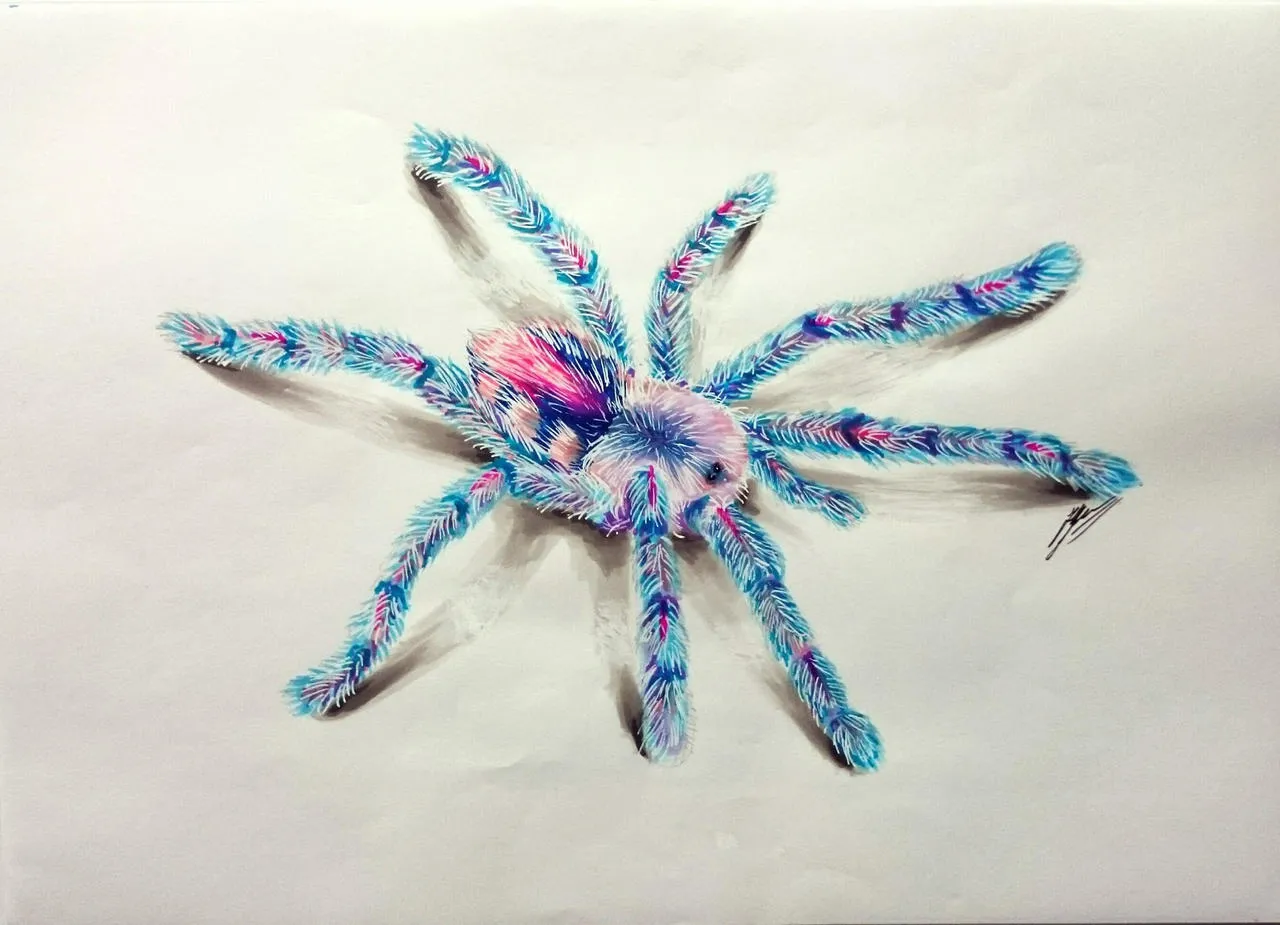
Maintaining proper temperature and humidity levels is crucial for the health of your Amazon Sapphire Tarantula. The ideal temperature range is typically between 75 to 85 degrees Fahrenheit (24 to 29 degrees Celsius). A heat mat or a low-wattage heat lamp can be used to maintain the required temperature. The temperature should be monitored using a thermometer, and the heat source should be regulated to avoid overheating. Humidity levels should be maintained between 70% to 80%. Regular misting of the enclosure with dechlorinated water is necessary to maintain humidity. A hygrometer should be used to monitor the humidity levels accurately. Proper ventilation is also crucial to prevent mold and fungus growth, so ensure there is adequate airflow within the enclosure.
Feeding and Diet
A well-balanced diet is essential for the health and growth of your Amazon Sapphire Tarantula. They are insectivores, meaning their diet consists primarily of insects. Offering the correct food items and feeding frequency are critical factors to their wellbeing. Ensuring your tarantula receives appropriate nutrition will not only help it grow but also maintain its vibrant coloration. Understanding their dietary requirements and feeding habits will help you care for this fascinating spider.
What to Feed
The primary diet of the Amazon Sapphire Tarantula consists of insects. Crickets, roaches (like Dubia roaches), mealworms, and other commercially available feeder insects are all suitable options. The size of the feeder insects should be appropriate for the tarantula’s size; juveniles should be fed smaller insects, while adults can eat larger prey. It is important to gut-load feeder insects, which involves feeding them a nutritious diet such as vegetables and commercial insect food, before offering them to your tarantula. This enhances the nutritional value of the meal for the tarantula. Avoid feeding wild-caught insects, as they may carry parasites or pesticides that can harm your tarantula.
Feeding Frequency
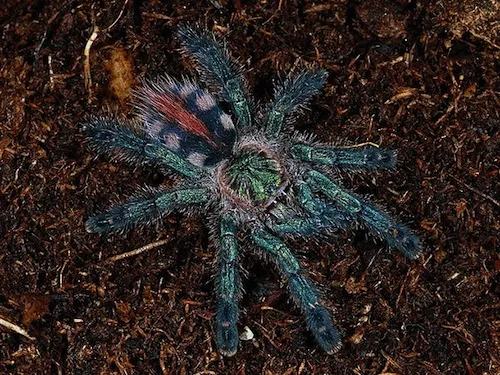
The feeding frequency for Amazon Sapphire Tarantulas varies depending on their age and size. Spiderlings and juveniles should be fed more frequently, typically 2-3 times per week. Adult tarantulas can be fed less often, about once every 1-2 weeks. It is important to monitor the tarantula’s abdomen. A well-fed tarantula will have a round abdomen. If the abdomen appears shrunken or if the tarantula is consistently refusing food, it may indicate a problem such as impending molt or illness. Remove any uneaten prey within 24 hours to prevent stress and the potential for the prey to harm the tarantula. Clean water should be available at all times.
Common Health Issues and Prevention
Like all tarantulas, Amazon Sapphire Tarantulas can be susceptible to certain health issues. Understanding these potential problems and taking preventative measures is important for keeping your tarantula healthy and thriving. This includes providing a clean and stress-free environment, a balanced diet, and appropriate humidity levels. Early detection and treatment of any illness or condition can significantly improve the chances of a full recovery. Regular observation and proactive care can help prevent many common health issues.
Moulting Process
Moulting, or shedding their exoskeleton, is a natural and essential process for tarantulas as they grow. During molting, the tarantula sheds its old exoskeleton to reveal a new, larger one underneath. Prior to molting, tarantulas often become less active and may refuse food. They will typically lie on their backs during the molt. It is important to avoid disturbing the tarantula during this vulnerable period. The new exoskeleton is soft initially and hardens over time. After molting, the tarantula’s colors may appear more vibrant. Provide a secure, humid environment during this time and avoid handling the tarantula until its new exoskeleton has fully hardened, which can take up to a week or two, depending on its size.
Parasites and Diseases

While Amazon Sapphire Tarantulas are generally hardy, they can be susceptible to some health issues. Parasites, such as mites, can infest tarantulas and cause irritation and health problems. A well-maintained and clean enclosure can help prevent parasite infestations. Other diseases can be related to poor environmental conditions or diet. If your tarantula displays unusual behavior, such as lethargy, loss of appetite, or unusual posture, it may be a sign of illness. If you notice any of these signs, it is crucial to consult with a veterinarian experienced in exotic animals. Preventative care, proper hygiene, and a healthy environment are the best ways to avoid health issues.
Conservation Status and Threats
The Amazon Sapphire Tarantula, while not currently classified as endangered, faces several threats in the wild that warrant attention. Understanding the threats they face and conservation efforts is important to ensure the continued survival of this beautiful species. Habitat loss, the pet trade, and environmental changes all contribute to their vulnerability. By increasing awareness and supporting conservation initiatives, we can contribute to the preservation of this captivating species.
Why are they threatened
One of the primary threats to the Amazon Sapphire Tarantula is habitat loss. Deforestation and habitat destruction, particularly in areas like the Amazon rainforest, destroy their natural environment. The collection for the pet trade also poses a threat, as an increase in demand leads to more collecting from the wild. While captive breeding programs help to meet the demand, unsustainable collection practices can impact wild populations. Climate change also affects the rainforest environment, resulting in alterations of the habitat conditions they require. These factors, combined, make it essential to support conservation efforts and promote responsible pet ownership to protect the Amazon Sapphire Tarantula and its habitat.
